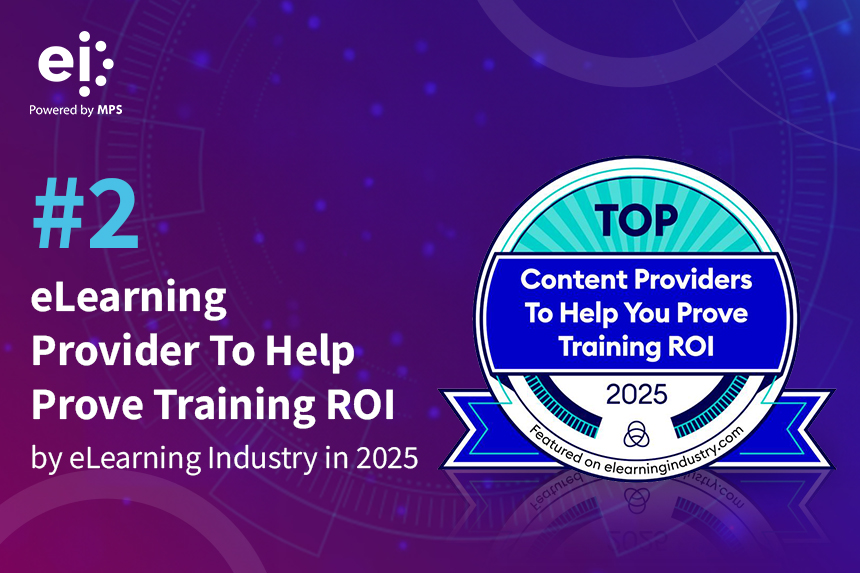
Artificial Intelligence (AI) is a catalyst for transforming eLearning content development. AI integrates personalized learning, customized delivery, automated assessment, and real-time feedback, enhancing eLearning content development efficiency.
What Is eLearning Content Development?
eLearning content development is the structured process of designing, developing, and delivering digital learning experiences. It involves instructional design, content authoring, multimedia integration, learner engagement strategies, and delivery through platforms like LMSs.
Traditionally, this has been a time-consuming process requiring input from SMEs, designers, and developers. However, AI significantly streamlines this by automating routine tasks, accelerating production, and enabling the delivery of engaging, adaptive, and learner-centric content.
Benefits of Leveraging AI in eLearning Content Development
Integrating AI into eLearning content development revolutionizes the way organizations deliver learning materials. Beyond automation, AI offers multifaceted advantages, enhancing every aspect of the learning experience. Here’s how AI benefits organizations in eLearning content development:
- Efficiency in Content Creation:
Automates data analysis, simplifies the creation process, and reduces time and resource requirements.
- Enhanced Consistency Across Courses:
Standardizes processes, maintains uniformity in material quality, structure, and delivery.
- Personalized Learning Experiences:
Improves comprehension and retention by personalizing learning experiences and customizing training content according to learner preferences and proficiency levels.
- Keeping Content Current and Relevant:
Ensures automatic content creation and modifications to keep the content relevant and aligned with current trends.
- Scalability of Learning Solutions:
Automates various processes, such as content creation, assessment, and feedback to accommodate growing numbers of learners, ensuring a scalable delivery of personalized learning experiences without compromising on quality or adding cost burdens.
- Automated Course Development:
Reduces the time and resources needed for content creation, streamlines content development processes – from planning to execution – and automates delivery and assessment.
- Intelligent Content Recommendations:
Maximizes learner engagement by suggesting relevant learning material on the basis of learner preferences and past interactions.
These advantages make AI a strategic asset for eLearning content development, enabling organizations to achieve both learning effectiveness and operational efficiency.
Maximize Generative AI in eLearning Content Development
Integrating generative AI tools into workflows can help Instructional Designers (IDs) enhance overall learning experiences, while focusing on pedagogical strategies and learner engagement. Generative AI facilitates eLearning content development through various methods, such as:
- Multimodal Content Creation:
Seamlessly integrates different modalities and synthesizes several media types, such as text, images, and audio, to produce engaging learning materials that facilitate greater understanding and retention of concepts.
- Content Summarization:
Uses natural language processing (NLP) techniques to quickly analyze large volumes of text, extract salient points, and distill key information into concise summaries, contributing to better comprehension and knowledge retention.
- Personalized and Adaptive Learning Experiences:
Analyzes user interactions and feedback to adapt learning materials in real-time and dynamically generate customized content, thereby optimizing learner engagement and learning outcomes.
- Consistency and Quality Assurance:
Utilizes automated quality checks and continuous refinement to generate standardized materials according to predefined criteria, ensuring consistency and quality assurance while minimizing variations or errors.
- Accessibility and Inclusion:
Automatically generates alternative formats, such as audio descriptions, captions, and translations, to make learning content accessible and inclusive for a diverse range of learners.
- Content Scalability:
Enables rapid expansion of course offerings to accommodate a growing number of learners, empowering organizations to scale training without compromising on quality or overwhelming human resources.
Let’s now look at how AI is applied in real-world eLearning content development scenarios.
Practical Applications of AI in eLearning Content Development
In the domain of eLearning content development, the practical applications of AI are extensive. Spanning from voice assistance to virtual presenters, AI fundamentally transforms the creation and dissemination of learning materials. AI’s practical applications in learning content development cover a range of areas, including:
- Voice Assistance and Course Translation:
Voice assistants and course translators leverage NLP algorithms to enable voice-activated interfaces to access learning content and provide real-time translation services, allowing seamless learner engagement with learning content.
- Course Customization and Personalization:
By analyzing learner data, AI enables the creation of personalized learning content and dynamically optimized paths tailored to user needs. These real-time adjustments improve engagement and better align with individual goals and proficiencies.
- Virtual Presenters:
Using NLP and speech synthesis algorithms, AI can create lifelike avatars that can interact with learners in real-time, resulting in a personalized and immersive learning experience with improved learner engagement.
- Automated Content Creation:
AI can use insights from learner data not only to generate diverse learning materials such as quizzes, tutorials, and interactive exercises, but also to streamline the content development process without compromising on quality or relevance.
- Expanded Engagement:
Virtual tutors leverage NLP and machine learning algorithms to provide learners with continuous support and guidance in the form of personalized assistance, answers to queries, and instantaneous feedback.
- Automated Grader:
Automated evaluation of assignments, quizzes, and exams, simplifies grading and assessment, offering learners timely feedback and reducing the burden on trainers.
- Chatbots:
NLP facilitates the creation of intelligent chatbots and semantic search engines that can respond to learner queries and streamline content organization for intuitive navigation.
- AI-Driven Efficiency:
Supports earlier-mentioned automation benefits by enabling quick, consistent production of digital content and reducing manual effort across development and delivery. - Gamification and Immersive Learning (VR/AR):
AI enhances gamification strategies and immersive technologies like VR/AR to create engaging, scenario-based experiences. These promote active learning through realistic simulations and challenge-based activities tailored to individual progress.
Such applications not only enhance interactivity but also ensure that eLearning content development remains responsive to learner needs and technological innovations.
How Does AI Help in Content Personalization?
AI enables dynamic personalization by collecting and analyzing data from a learner’s behaviors, performance, preferences, and goals. Based on this data, AI algorithms can:
- Curate unique learning paths
- Adjust content difficulty in real time
- Recommend supplementary resources
- Personalize feedback and support
How Can AI Improve eLearning Content Delivery?
AI enhances both content creation and delivery processes, strengthening instructional design and advancing overall eLearning content development:
- Real-time Adaptation: AI adjusts the pace, format, and difficulty of content during delivery to suit individual learning styles.
- Automated Microlearning: AI breaks down larger courses into bite-sized modules delivered at optimal times based on learner activity.
- Smart Notifications and Nudges: Learners receive timely, AI-generated nudges to maintain engagement and complete courses.
- Voice and Chat Interfaces: AI-driven assistants can guide learners, answer questions, and provide just-in-time support.
These delivery innovations help learners stay motivated and complete their training journeys successfully.
How to Use AI for Content Creation in eLearning?
AI-driven tools support content creators in multiple ways:
- Script Writing: NLP tools can draft instructional scripts, case studies, and video dialogue.
- Image and Audio Generation: AI can produce visuals, infographics, or generate voiceovers and background scores.
- Scenario-Based Learning: With prompt inputs, generative AI can build branching logic and realistic simulations.
- Quiz Creation: AI tools can auto-generate assessments with varied question types and immediate feedback.
Challenges of Using AI in eLearning Content Development
Incorporating AI into eLearning content development offers immense potential but also presents notable challenges. These challenges, if not addressed effectively, can hinder the effectiveness and integrity of the learning experience. Using AI in eLearning content development can pose several challenges as listed below:
- Risk of Over-Automation:
Excessive reliance on AI can lead to a lack of personal touch and human oversight crucial for effective learning, resulting in impersonal learning experiences.
- Potential for Bias:
It is essential to use unbiased data sets to train AI tools, as algorithms may amplify existing biases, leading to unfair or discriminatory learning outcomes.
- Data Privacy Concerns:
Data privacy poses a significant challenge, as questions may arise regarding how the data is collected, stored, and used. Implementing robust privacy policies and security measures can safeguard learner information and ensure compliance with data protection regulations such as GDPR or CCPA.
- Depersonalization:
A by-product of excessive automation, depersonalization can diminish human touch and adversely impact learner engagement.
- Quality Control and Standard Compliance:
Automation may produce inaccurate content that lacks relevance or adherence to prescribed training standards. Human oversight can ensure quality control and standard compliance to maintain the integrity and alignment of training content with established standards.
Mitigating Challenges through Thorough Validation and Testing
Thorough validation and testing procedures that effectively address biases, ensure data privacy, and maintain quality standards can help overcome the challenges posed by AI. Several approaches to overcome the challenges of using AI in eLearning content development include:
- Curating Content Sources:
Selecting reputable sources and relevant materials for content curation to support overall learning objectives. Ensure reliability and accuracy of data used for AI training.
- Comprehensive Review Processes:
Implementing multi-layered review strategies to ensure accuracy, consistency, and quality across all materials, while minimizing errors. Involve multiple reviewers with diverse expertise and perspectives to identify and address potential issues.
- Data Privacy and Security Measures:
Adopting stringent data protection policies to safeguard learner privacy, maintain trust, mitigate the risks of data breaches, and comply with regulatory requirements. Prioritize security and confidentiality of learner data to create a safe and ethical learning environment.
- Bias Mitigation Strategies:
Utilizing diverse data sets and continuous monitoring to minimize biases, improve model performance, and ensure accuracy, fairness, and relevance of AI-driven processes.
- Balancing Automation with Human Oversight:
Combining AI capabilities with human expertise to ensure that learning materials meet learner needs, uphold training integrity, and deliver meaningful learning experiences.
- Responsible AI Use:
Prioritizing ethical considerations to ensure fairness, transparency, and accountability in decision-making processes. Adhere to ethical guidelines for deploying AI tools in eLearning environments to minimize potential harm, build learner trust, promote inclusivity, and maximize the positive impact of AI technologies on learning initiatives.
Top Generative AI Tools for eLearning Design and Development
Generative AI tools can help IDs create dynamic and personalized learning experiences, enhance learner engagement, and achieve better learning outcomes in diverse educational settings. Some of the top generative AI tools for eLearning design and development include OpenAI’s GPT-3, Articoolo, Articulate Rise, Adobe Captivate, Elucidat, and Adapt.
As cloud-based platforms with collaborative features and analytics, generative AI tools enable IDs to streamline content creation, track learner progress, and optimize course effectiveness through data-driven insights. These user-friendly authoring tools often feature customizable templates and assessments that make eLearning content development easier, faster, and more scalable. With features such as scenario branching, interactive simulations training, and responsive design capabilities, these tools help create device-agnostic, yet engaging and immersive learning experiences.
What Is the Future of AI in eLearning?
The future of AI in eLearning focuses on creating more intelligent and emotionally responsive learning systems. Emotion-aware learning is an emerging trend where AI can detect a learner’s emotional state using behavior patterns or visual cues and adjust content or feedback to maintain engagement. AI will also support hyper-personalized learning journeys that adapt in real time to each learner’s goals, performance, and preferences. This enables the delivery of content that is both relevant and timely, improving learning efficiency and outcomes.
AI will also enhance collaboration between technology and instructional designers. While AI can generate content quickly and at scale, human input remains essential to provide context, empathy, and pedagogical value. Real-time skill validation through AI-driven simulations and scenario-based assessments will offer more accurate insights into both technical and soft skills. As these capabilities expand, it becomes important for organizations to adopt ethical AI practices that promote transparency, fairness, and accountability. Responsible integration of AI will help build scalable, inclusive, and effective learning environments.
Closing Thoughts
AI’s ability to deliver dynamic and personalized learning experiences tailored to individual needs and learning styles holds immense transformative potential in eLearning. Organizations can maximize the benefits of implementing AI in eLearning content development by adopting a mindful approach that acknowledges and addresses the challenges inherent to AI. These include biases, data privacy concerns, and the need for responsible and ethical use of AI.
Striking the right balance between AI-driven enhanced learning outcomes and vigilance about potential risks can enable organizations to responsibly harness the power of AI in creating a more effective and inclusive learning environment for a diverse range of learners.
Explore 2025 L&D Trends
Leverage the latest L&D trends to develop a comprehensive L&D strategy that drives business results and future-proofs your workplace learning strategy.
Frequently Asked Questions (FAQs)
- What is the difference between AI and Generative AI in eLearning?
AI covers a broad range of intelligent systems, while Generative AI refers to systems that create new content like text, simulations, and visuals from prompts or data. - Is it possible to modernize legacy eLearning content using AI?
Yes. AI can analyze outdated material, generate summaries or rewrite sections, and even enhance visuals and media for modern delivery. - Is AI suitable for soft skill training?
While AI can support soft skill training through roleplays and virtual simulations, it works best when paired with human feedback and coaching. - How do I start implementing AI without heavy investment?
Start with low-cost tools like AI-powered quiz generators or content summarizers. Gradually build toward adaptive learning and automation features. - How do I ensure AI doesn’t introduce bias or error into my training?
Use diverse datasets, include human oversight, and test AI outputs regularly to ensure fairness, relevance, and accuracy.



